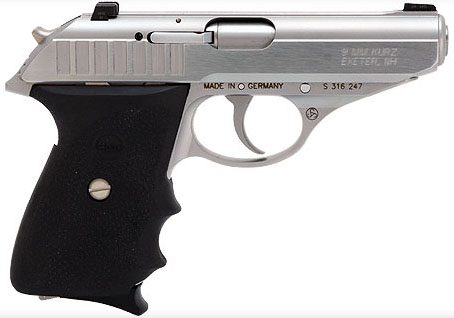|
The SIG SAUER P232 .380 Pistol: Another Viewpoint By David Tong  Sig-Sauer is one of my favorite firearms manufacturers, because of their superior accuracy and function from production grade offerings. While I might take some issue with their model proliferation of cosmetic variations, mostly the news is good from Exeter, New Hampshire. This article, however, is about my criticisms of the current Sig P232 .380 pistol and errors in some of the ergonomic choices that result in a less user friendly handgun. As many of you are aware, the P232 is a lightly modified version of the prior P230 pistol, which was sold during the 1980s and 1990s. It is physically identical, made of the same materials and is a traditional double-action / single-action, blowback actuated, fixed barrel, self-defense pistol. The 232 gained the now de rigueur firing pin intercept in addition to a rebounding hammer and 10 pound DA trigger pull. (As if that wasn�t enough �drop safety.�) Externally, the main changes have been the material and style of the grips. The P230 had a pair of plastic grip panels with a checkering pattern on the palm area of each. The back strap area, as well as the area where one�s thumb and trigger finger would be placed, was smooth. I found this grip to be nearly ideal. It allowed for a quick grip to be attained and, because of the slickness of the rear strap, there was no design impediment to slow it down. Such firm purchase around the stock means if one does not index their hand precisely when drawing the pistol, it may not quite be correctly positioned in the hand or aligned with the long bones of the arm for proper control. The standard plastic grip on a P232 is a highly stippled one, while latest production versions have Hogue finger grooved rubber one-piece wrap around grips, which adds a tacky feel 360-degrees around the grip frame. It provides secure purchase to be sure, but if anything is even slower. The bottom line is small adjustments in your hand to align the pistol with your forearm are made difficult. Of course, this little quibble can be overcome by changing the grip panels or a level of practice commensurate with the seriousness of the mission of the self-defense pistol. The other issue is not so easily resolved and is one that I believe Sig-Sauer should address. The P230 had fine cocking serrations that provided good purchase. Chuck Hawks mentioned in his review of the P232 that the pistol�s slide was difficult to rack to load the chamber and he recommended that users thumb cock the hammer before racking the slide, to reduce the spring tension holding the slide closed. I did not understand his comment, because my experience with the P230 did not pose any problem racking the slide. After the first 30 seconds of handling the P232 however, I understood his concern. The widely-spaced, smoothly scalloped serrations that the company used on the P232 for slide gripping surfaces do not come close to the same level of grip that the P230's afforded. In addition, it seems to me that the recoil spring weight, as well as that of the hammer mainspring, was increased. Perhaps this was to address potential durability concerns when firing latter day, high-performance defense ammunition in a non-locked breech handgun. However, SAAMI pressure specs for the .380 have not markedly changed, because of the proliferation of blowback pistols in the caliber. Perhaps the company is simply being very cautious by the fitment of these springs. What is different, though, is the pistol�s slide has become extremely hard to rack. More difficult than a 1911 with an 18.5 pound recoil spring and full power mainspring, worse than the delayed blowback Heckler and Koch P7, arguably even harder to rack than the huge Desert Eagle gas operated Magnum pistols. This makes it all but impossible for people with average or less than average hand strength to comfortably practice with the P232. Besides the usual �slingshot� method of grasping the slide grooves from behind the pistol, I also used the overhand method of grasping the slide grooves with the left hand, pushing backwards from the front of the pistol while the shooting hand on the grip pushed forward. Even then, I was only able to rack the slide when the hammer was cocked. After the many dozens of semi-automatic pistols I have handled and shot over the decades, I must admit this one flummoxed me. While I still think that the P232 will function well and shoot accurately, some minor changes are necessary to ensure that the likely customer base in the market can actually use it without undue effort. Note: A full review of the SIG SAUER P232 Two-Tone (stainless/aluminum) can be found on the Product Reviews page and a review of the P232 Stainless (pictured above) can be found on the Handgun Information - Reviews index page. |